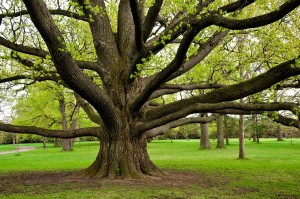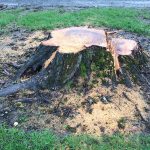Pruning Mature Trees in Spring
Pruning mature trees requires a little more finesse than does pruning a newly planted one. See our earlier post for how to prune trees during their first few years.
New trees need minimal shaping. As a tree moves past childhood, it begins to show its adult character. At this point, between the ages of 4 -7 years, you’ll want to follow guidelines for pruning mature trees.
Shaping an Established Tree

When a tree gets this big, it is best to call on a professional arborist to take care of the pruning.
The best time to perform annual pruning is when a tree is dormant in winter and early spring. It’s OK to trim during the growing season, but doing so will slow your tree’s growth. Remove dead or damaged branches as soon as you notice them, at any time of the year. Don’t hesitate to call Inexpensive Tree Care if you need help with a tree.
Here’s how to prune a tree that’s established but still young.
- Prune low limbs: Now’s the time to cut branches that could get in the way of traffic. If foot traffic will pass beneath the tree, remove branches lower than about 7 ½ feet. For vehicular traffic, you’ll need a clearance of around 11 feet.
- Remove crossing branches: Prune away branches that cross, rub together or are growing toward the trunk.
- Create airflow: If the canopy is too crowded the tree will suffer from poor air flow. Try to prune so branches are separated by about a foot.
- Don’t get carried away: Don’t remove more than about 25 percent of a tree’s canopy. If you keep up with yearly pruning, you won’t be faced with a tree that’s out of control. A mature tree is the work of many years; you’ll have a chance to prune more next year.
Technique for Pruning Mature Trees
Branches smaller than an inch can be removed with bypass cutters. Branches larger than this are too thick for cutters. Remove branches with a diameter up to 4-inches with a pruning saw using the following 3-step technique to protect the bark against tearing:
Cut just outside of a tree branch collar. The collar is the slight swelling where the base of a branch attaches to the tree. Cutting the collar slows the trees ability to heal. Here’s how to make a cut without tearing the bark of the tree:
- Make an undercut: About 6 inches out from the collar, cut from the bottom side of the branch about one-third of the way through.
- Remove the branch: Two inches farther from the trunk, cut from the top side of the branch all the way through.
- Cut off the stub: Remove the branch stub just beyond the collar. Don’t cut flush with the trunk.
Leave High Branches to the Pros
A chain saw is the most efficient tool to remove branches thicker than about 4 inches in diameter. Once your tree gets this large, it’s best to call on us. We’ll remove large, high branches safely. Your trees will stay healthier when they receive annual pruning.
For a free estimate, contact us today!



